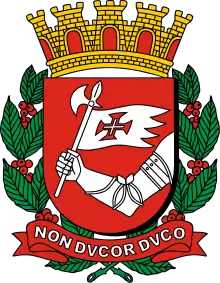Ipiranga (district of São Paulo)
Ipiranga (Portuguese pronunciation: [ipiˈɾɐ̃ɡa], from the Tupi (y, river; pirang, red) for "red river") is an historical district located in the subprefecture of the same name of São Paulo, Brazil.[1] The name Ipiranga comes from the river (which now is a brook) of the same name located in the region, which means "red river" in a Tupí–Guaraní language. The Independence Park (Parque da Independência), where supposedly the Emperor Pedro I of Brazil proclaimed the independence of Brazil, the Paulista Museum, which exhibits classic architecture and a collection of Brazilian colonial artifacts, and the Museum of Zoology of the University of São Paulo, are also located in Ipiranga.
Ipiranga | |
|---|---|
 Location in the city of São Paulo | |
 A view of Paulista Museum in the Ipiranga district, crowded in celebration of Brazilian Independence Day | |
| Country | Brazil |
| State | São Paulo |
| City | São Paulo |
| Government | |
| • Type | Subprefecture |
| • Subprefect | Danilo Antão Fernandes |
| Population (2000) | |
| • Total | 98.863 |
| HDI | 0.883 –high |
| Website | Subprefecture of Ipiranga |
The Ipiranga Brook is perhaps one of the most famous Brazilian brooks, because it is mentioned in the first line of the Brazilian National Anthem.
The region near the Tamanduateí River had industrial characteristics, to the point where buses and trams heading there had the destination labeled "Factory". The area next to Nazaré Avenue, in contrast, is filled with mansions of wealthy families and a number of colleges, like Unesp and São Camilo, and workers of the factory's houses.
The commercial center of Ipiranga concentrates on Silva Bueno Street. There are banks, clothes stores and grocery stores like the famous Chocolândia.
In 2007, this neighborhood was served with the installation of a new metro whose station is named Alto do Ipiranga. It is located at Gentil de Moura Street and connects passengers with the green line of São Paulo Metro. Paulista Avenue - one of the most important avenues in São Paulo - is about 5 or 6 stations distant from Alto do Ipiranga depending on the precise destination.
